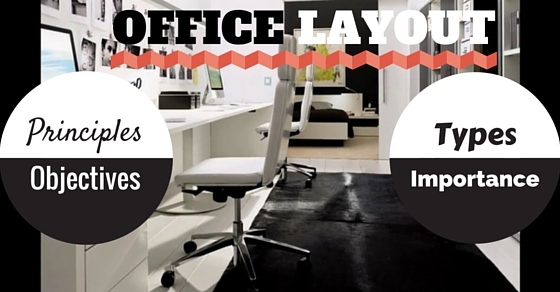When you go for an interview, you are first exposed to the office layout wherein you would experience the different styles present there. There are many companies who take care of the working environment so that it has a pleasant look.
In fact, newcomers or job seekers are so impressed with the office layout that they don’t mind getting any position in that company!
What does this office layout mean?
It is nothing but the arrangement of furniture, supplies, equipment, procedures and things necessary for work in a proper manner in the available space, that would give maximum output. Here we have discussed a few types and importance of office layout.

Define Office Layout:
It is nothing but positioning or organizing all the office needs and resources in the space
available.
As per Hicks and Place, “The problem of layout relates to the arrangement in the space involved so that all the equipment, supplies, procedures and personnel can function at maximum efficiency”.
Choice of Office Layout:
For an office layout, the office management has to first decide the location, which is very important. The location can be at any urban centre or any suburbs a little away from the city. When making such a decision, you need to look for things that are linked to it like transport, resources nearby etc.
Nowadays, in western countries, most of the businesses are choosing suburbs as their location to set up offices. It has turned out as a trend.
Some of the reasons for it are,
High cost:
When compared to the city, the suburbs are cost-effective and low for office space.
Congestion and Overcrowding:
Cities are more crowded whereas suburbs are not that dense in terms of population
Growing Transport Facilities:
Commuting facilities have been grown unlike earlier days.
Communication Facilities:
The maintenance cost is low in suburbs and also the different communication facilities have helped companies to locate in suburbs from cities.
Factors Affecting Office Layout:
After the choice of office location is done, there are few factors that we need to look at when choosing a proper office space. Some of the top factors are,
- The office should comprise of the minimum required space
- Localization effects
- Factor of taxes
- Healthier surrounding
- Availability of various services
- Transport availability
What is the Importance of Office Layout?
Work that needs to be executed for each type of task requires the necessary equipment within the allotted space. The office layout has to be designed in such a way that it is comfortable as well as functional.
A lot of money and time is invested in designing those layouts. There are various reasons behind the need of having a proper office design layout.
1. Impacts morale:
Studies have shown that the layout of an office impacts employee morale which affects the functioning. When we say layout, it does not imply only the décor and facilities, but the relationships between people who work there and the general environment. Often this is referred to as ergonomics.
2. Impacts business:
As layout has an impact on the morale, it directly impacts the efficiency and thereby the business success rate. The more the people working there are happy, the better is the output. This is a direct link to the business success factor.
3. Way the work is done:
The traditional style of work like working at one desk or work executed by only one person has been replaced by a re-engineered organizational structure. The work or task at this modern age has changed due to globalization that is governed by the use of information technology. The tremendous developments in this technology have impacted the office working hours and way to perform the tasks.
4. Manage changes:
Businesses are prone to changes to manage the pressure of the market needs. To keep up with it, layouts are effective only when the changes can be accommodated within. Hence, having simpler layouts helps businesses to re-design whenever needed so that it does not affect the tasks being executed or the work done.
5. Increase productivity:
Using office space effectively is important while designing office layouts. It should be such a way that it does not delay the work and job gets done quicker consuming less time. In other words, the flow of work is not interrupted.
6. Facilitate Supervision:
When office accommodation and layout is designed to place managers or supervisor closer to their teams, they can meet or discuss issues immediately and get solutions. Communication gets smoother and quicker.
How?
There would be a reduced number of internal memos or emails or movement of staff. The working conditions would be better as their workstations are placed in relation to their work and needs.
7. Effective use of equipment:
Designing office equipment properly is indeed very important so that it is not underused or overused. Providing at the place where the work needs to be completed is crucial. The power consumption is evenly distributed and the noisy equipment is placed away from workplaces where silence is required.
Hence, you would now know that the positioning of workstations is crucial. For this you need to pay attention to some of the issues like the provision of sufficient space, assessing the needs of staff, the design of workstation; in short complete office design.
What are the Objectives of the Office Layout?
The minimum standards to be followed are:
1) To ensure the proper utilization of space so that the spaces provided are effectively used.
2) To ensure that workflow is uninterrupted and there is the maintenance of steady flow.
3) To ensure that managers can supervise their team members in a better way.
4) To be able to provide a comfortable work environment which brings satisfaction.
5) To enable better communication between the team members.
6) To provide a safe working environment.
7) To have provisions for future expansions.
Principles of Office Layout:
The main principle behind the office layout design should be such that it occupies the available space in an economical way so that the aim and objectives of the organization or business is achieved.
The layout must be effective such that the workstations are planned to be positioned such that data is being transmitted with minimal costs and information can flow with minimum delays or without interruption.
The workstation has to be provided with items necessary for executing the job. Care has to be taken for storage of information and documents. Listed are some of the principles to be taken care while designing
1. Natural lighting:
Designing offices that face the north or east gets more of natural lighting. It avoids more consumption of power.
2. Placing computers:
Desks having computers or desktops must be placed in such a way that staff sitting at it must not have their backs or faces to the windows.
3. Designing work tables:
It is preferable to seat staff not facing each other. It is said to disrupt work. Besides having minimum intrusion is better. Also reducing the field of vision of employees to other employees will reduce distraction.
Also, they need to be provided with adequate lighting, ventilation, and ergonomic chairs and tables to prevent eyestrain and muscle aches.
4. Flow of work:
By carefully studying the sequences of the tasks to be done, the design of the workspace is imitated. If the person has to go back and forth in the space it will bring frustration and reduce output. Ensure that the flow of work is smooth and in one direction.
5. Pleasant:
The most important of all the aspects is that design should be aesthetically pleasant. Do not concentrate on functionality alone but also on its looks. Space has to be optimally used.
6. Provision of tools:
Assignments are completed quickly if they have the necessary space and tools to perform them. The work station should be spacious enough to accommodate their files, papers and their documents. Having copiers and printers closer to them is better to avoid them frequently moving out and wasting their time.
7. Grouping:
Placing the same functional type of work together or closer to each other will help to reduce time wastage. The employees have the freedom to consultation and information easily so that work is handled efficiently. Hence, it is better to list out the functions or tasks that employees perform and design the office planning and layout accordingly.
8. Open a private space:
The employer needs to verify which tasks require collaboration with one another and which set of tasks require concentration. Based on this, specific cubicles are designed with open or low separators and others with separate cubicles or traditional with closed doors. Making a separation between the two types is essential
9. Informal and formal spaces:
Every workspace does require employees to take breaks in between work. For this, communal spaces are designed that is closer to the work stations. These informal communal spaces are often built with more space to accommodate large numbers during coffee or lunch breaks. The informal communal spaces meant for conferences or meetings are often placed away from busy workspace that is noisy.
10. Security:
As it is aware that information is very critical to any business, care needs to be exercised to define a level of security and norms for workstations processing data. Mainly the storage of confidential and sensitive data has to be placed away from main workspace and protected.
11. Reducing risk:
Designing has to be such that it reduces the risk of accidents or falls. Allowing ergonomic norms of wiring and placing of tables, chairs, and work stations provide safe working conditions. The safety would be maintained.
12. Reduce distances:
While figuring out the workspace the distance between movements of each task has also to be considered. Movements like walking, carrying, pulling consumes time and energy. It causes exhaustion thereby reducing effectiveness. Hence, distances has to be reduced to minimize costs and energy.
What are the Different Types of Office Layouts?
The office layouts are broadly classified as general office layouts and private office layouts. The latest layouts are combination offices, a co-working office, narrative layouts, nodal layouts, neighborly office, and nomadic office.
When talking about “what are the types of office”, the general office layouts are of two types
- Open plan office layout
- Landscape office layout
1. Open plan office layout:
As the name indicates, the open office plan layout does not have walls or separators or passages. Cupboards, shelves screens, cabinets serve as separators between workstations. All staff are seated in the same direction. This is useful for teams and employees who are working on a similar project.
The advantages of open plan office are:
1) To reduce costs and saves space.
2) To facilitate communication as there are no phone calls and fewer memos.
3) To adapt to changes
4) To help supervise all staff
5) To increase the effectiveness of heating, lighting
6) To motivate staff within a group.
The disadvantages of open plan office are:
1) Distracts people from work due to noise
2) No privacy for confidential matters
3) Impersonal atmosphere.
4) The spread of infections is easier
2. The landscape office layout:
The concept is the same as open plan layout with the only difference being that the staff are seated in different directions unlike in open plan style. It was not preferred much as it did not give privacy and the staff working in such layouts complained of being exposed to noise and continuous movement of people around them.
It was also said to have destroyed the conventional forms of politeness and being civil. It later was referred to as ‘modified\ open plan style’ with plants around and preassembled cubicles that can be moved accordingly to accommodate more people.
The private office layout:
The private office layout refers to cellular styles where the interior walls stretch from floor to the ceiling. The space is normally occupied by one person, but depending on the company’s budget, two or three are accommodated. But mostly it is preferred seating for senior management to give privacy.
Though it is considered as a privilege and prestigious to occupy, these type of offices are indeed a valuable place as it indicates a high level of confidence in the work of the occupants. The private offices are often given where privacy and confidentiality is required.
Besides, these offices are secured well through proper locking systems. These types of offices are lined along passages or sometimes ad hoc according to space.
The combination office:
It is a combination of open and cellular types where the individual and multicellular types co-exist. The offices surround the common spaces instead of being connected through hallways. This helps for individuals to concentrate or focus on work and also allow communication within the team, denoting the person(s) has to perform solo and group activity.
Co-working office:
With laptops replacing personal computers, employees are increasingly becoming mobile with their work. The arrangement where the office is considered as a common sharing place where employees come and go. The worker is exposed to an open office style with no specific allocation of desks.
It’s suitable for self-employed where the individuals can pay a small fee. This helps them to interact with customers and also enjoy networking.
The narrative office:
As story narrates about the character in depth, so does this style of layout that describes the ‘brand’ of the company. This approach is to make the office itself get involved in the marketing of its brand wherein all the staff are considered as brand managers or front line staff.
The nodal office:
The office is designed such a way that it is considered as a hub or node for knowledge where all other offices are connected.
The neighbourly office:
Here the office is designed to give a look like a familiar neighbour with a landscape with it. It gives a feeling of being social.
The nomadic office:
As the name itself suggests, the office design principles are typical of nomad style wherein the workspace is distributed within.
Advantages of a Good Office Layout:
- Better Goodwill
- Better Morale
- Reduction of Cost in Office Maintenance
- Economic Stabilization
- Promotes Efficiency
- Improves Quality of Supervision
- Best Uses of equipment and Machines and Equipment
- Speeding of Inter-department Communication






































